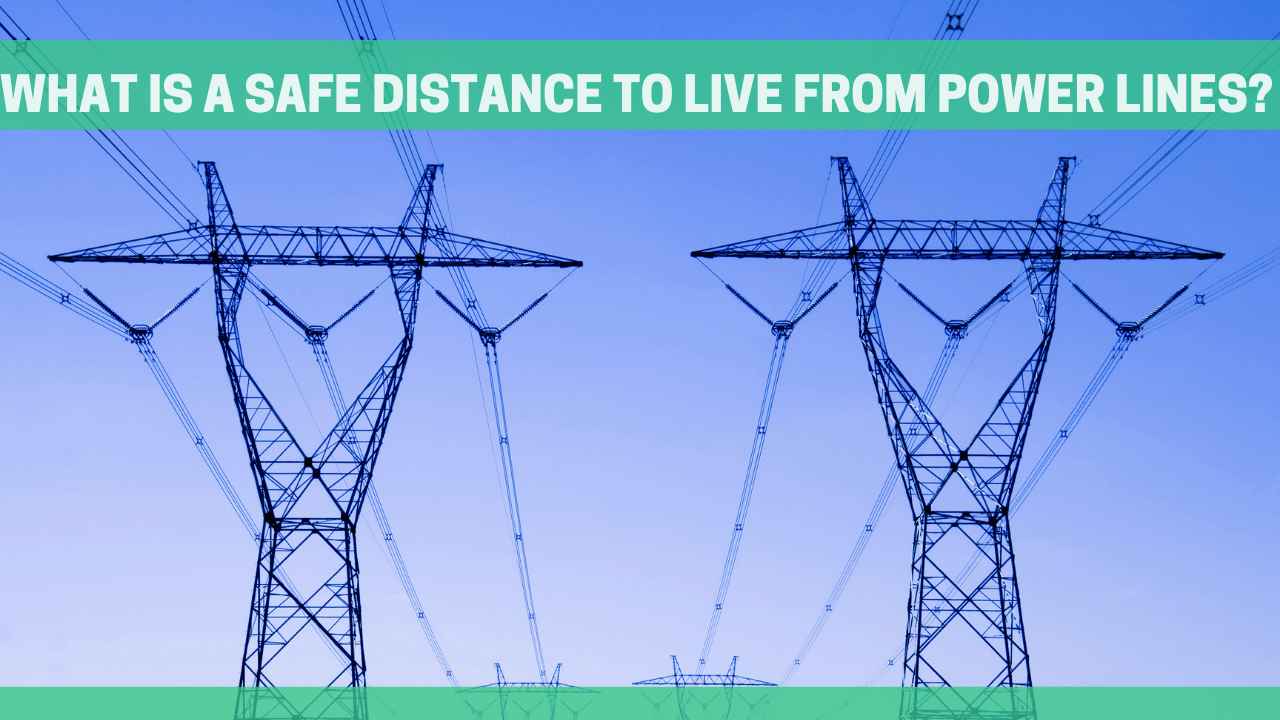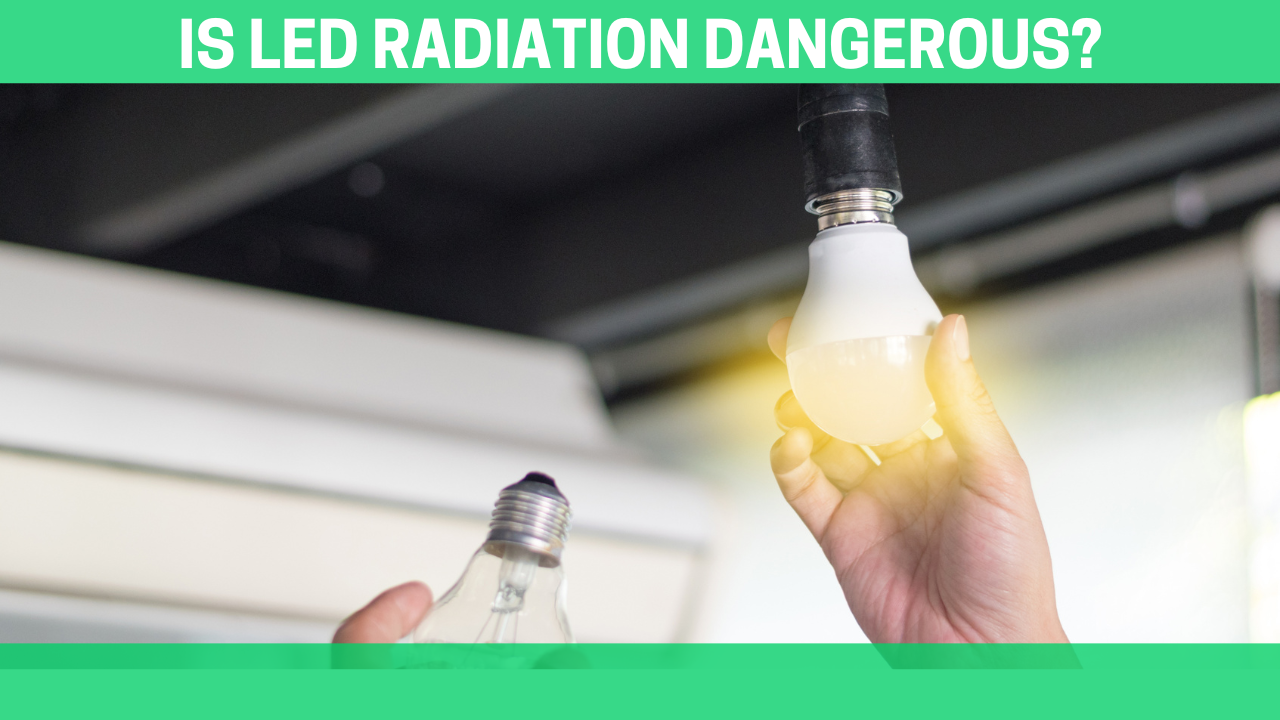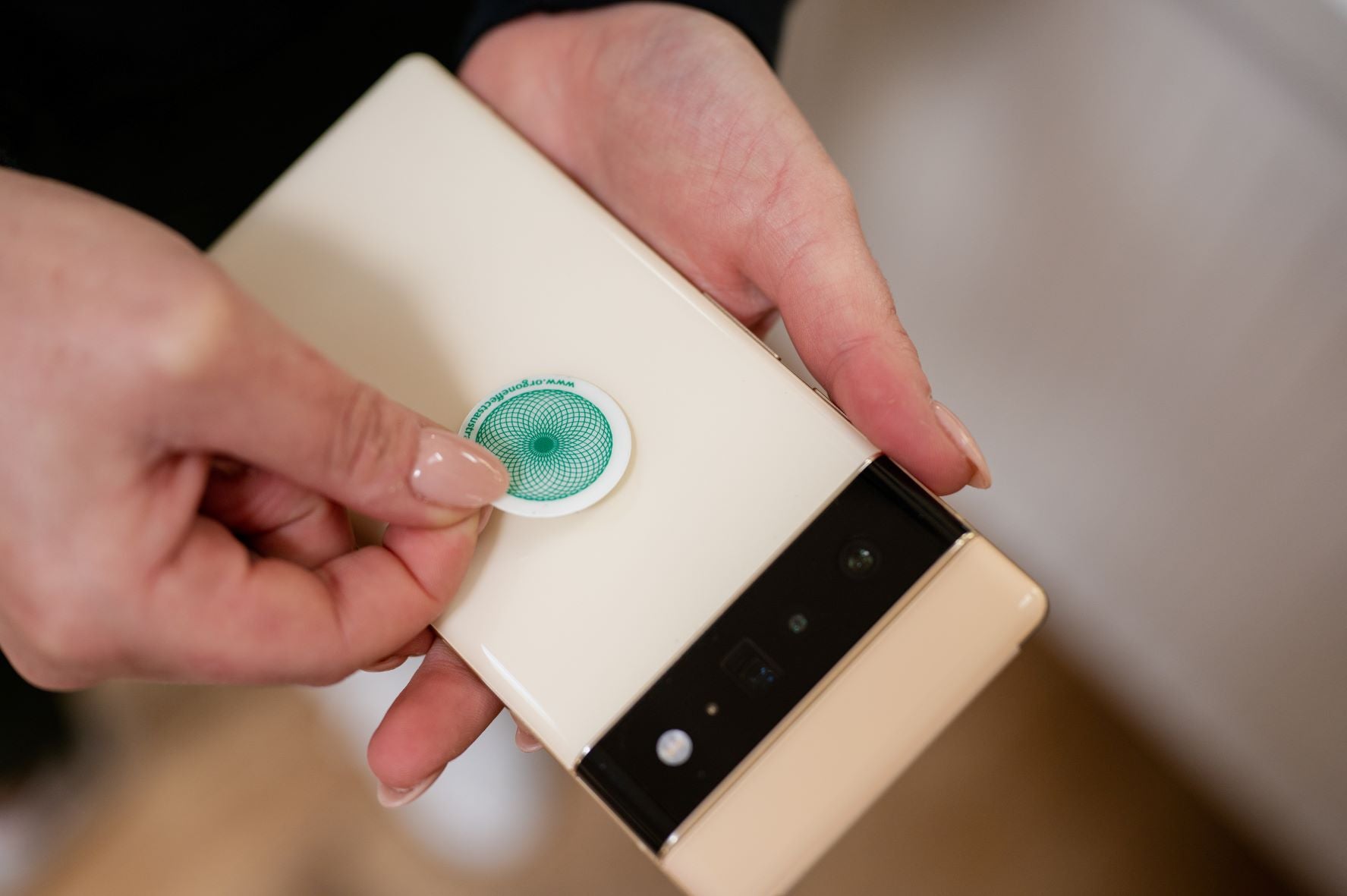Are you aware of the potential risks associated with living or working near power lines?
With the increasing number of power lines in urban areas, it has become crucial to understand the importance of maintaining a safe distance.
In terms of radiation and EMF protection, we usually think of dirty electricity, home wireless devices, smart meters, and cell phones. What is often forgotten is the enormous danger posed by electromagnetic radiation from power lines.
Whether you are a homeowner, business owner, or simply concerned about your well-being, this article will provide you with the necessary information to make informed decisions.
Understanding the Risks of Overhead Power Lines

Power lines are usually seen overhead. They are a seemingly endless cabling system connected by large masts in a network system.
Poles are generally safe because they are simple wooden poles that only carry the wire, or shielded metal or plastic poles that protect internal wiring.
However, the power lines themselves, which carry a voltage of almost half a million volts, emit magnetic and electric fields.
This EMF radiation emits in any direction up to a quarter of a mile from the lines, polluting our neighborhood with a staggering amount of radiation.
Understanding Electromagnetic Fields (EMFs)

Electromagnetic fields (EMFs) are invisible areas of energy that are emitted by various sources, including power lines. These fields consist of electric and magnetic components that are generated by the flow of electricity.
While we are surrounded by EMFs in our daily lives, it is important to understand the potential risks associated with prolonged exposure to high levels of EMFs emitted by power lines.
Exposure to EMFs has been a topic of concern for many years, with studies suggesting a possible link between EMF exposure and certain health conditions.
One such condition is childhood leukemia, with some studies indicating a small increased risk for children living near power lines.
However, it is important to note that the overall risk is still considered to be very low, and further research is needed to establish a definitive causal relationship.
Potential Health Risks Associated with Prolonged Exposure to EMFs

While the exact health risks associated with prolonged exposure to EMFs are still being studied, there are a few potential health effects that have been identified. These include:
- Increased risk of cancer: Some studies suggest a possible link between long-term exposure to high levels of EMFs and an increased risk of certain types of cancer, such as childhood leukemia and brain tumors. However, the evidence is limited and further research is needed to establish a definitive causal relationship.
- Effects on the nervous system: Prolonged exposure to EMFs has been associated with symptoms such as headaches, fatigue, dizziness, and difficulty sleeping. These symptoms are often referred to as "electromagnetic hypersensitivity" (EHS) and can vary in severity from person to person.
- Reproductive health effects: Some studies have indicated a possible link between EMF exposure and reduced fertility in both men and women. However, more research is needed to confirm these findings and understand the underlying mechanisms.
It is important to note that the majority of people are not exposed to high enough levels of EMFs to cause significant health effects. The potential risks are more relevant for individuals who live or work in close proximity to power lines, where the EMF levels may be higher.
Is It Dangerous to Live Near Power Lines?

Power lines generate magnetic field radiation and electric field radiation. Radiation from electric fields, while quite harmful, is stopped or shielded relatively easily, and most buildings are shielded from this type of EMF.
The real danger is the magnetic fields created by power lines because they can penetrate most things.
Fortunately, there are a few things you can do to protect your home from this type of radiation, such as EMF protective products, that can neutralize the EMF you are exposed to.
The most important thing when it comes to magnetic radiation from power lines is distance because distance from the source gives you exponential certainty by inverse square law.
Check out The Ultimate EMF Meter Review
Regulations and Guidelines for Safe Distances from Power Lines

To ensure public safety, various organizations and regulatory bodies have established guidelines and regulations for safe distances from power lines.
These guidelines take into account the potential health risks associated with EMF exposure and aim to minimize the risk to individuals living or working near power lines.
In most countries, the guidelines for safe distances from power lines are based on the "exposure limits" set by the International Commission on Non-Ionizing Radiation Protection (ICNIRP) and the Institute of Electrical and Electronics Engineers (IEEE). These exposure limits are designed to protect against both the thermal and non-thermal effects of EMF exposure.
The recommended safe distances vary depending on the voltage of the power lines. For example, the ICNIRP guidelines recommend a minimum distance of 50 meters for power lines with a voltage of 220-380 kilovolts and a minimum distance of 10.5 meters for power lines with a voltage of up to 110 kilovolts. These recommendations are based on the assumption that the power lines are operating at full capacity.
It is important to note that these guidelines are intended to be a general recommendation and may not account for all individual circumstances.
Factors such as the height of the power lines, the configuration of the electrical system, and the presence of other conductive structures can affect the EMF levels at a given distance.
Factors to Consider When Determining the Ideal Distance
While the recommended safe distances provide a general guideline, it is important to consider additional factors when determining the ideal distance from power lines. These factors can help you assess the potential risks and make informed decisions about your safety. Some of the key factors to consider include:
- Voltage and capacity of the power lines: Higher voltage power lines generally have higher EMF levels. Additionally, power lines operating at full capacity may emit higher levels of EMFs compared to those operating at lower loads. Understanding the voltage and capacity of the power lines near your home or workplace can help you assess the potential risks.
- Configuration of the electrical system: The configuration of the electrical system, including the number of power lines and their proximity to each other, can affect the EMF levels at a given distance. Power lines that are closer together or parallel to each other may result in higher EMF levels.
- Distance and height of the power lines: The distance and height of the power lines from your home or workplace can affect the EMF levels. Generally, the EMF levels decrease with increasing distance from the power lines. However, it is important to note that the EMF levels can vary depending on the height of the power lines and the location of the measurement.
- Presence of other conductive structures: Other conductive structures, such as metal fences, buildings, or other power lines, can affect the EMF levels in the surrounding area. These structures can reflect or amplify the EMF levels, potentially increasing the exposure.
By considering these factors and conducting a thorough assessment of your environment, you can determine the ideal distance from power lines that ensures your safety and minimizes your exposure to EMFs.
What is the Minimum Safe Distance from Power Lines?

If you live near a power line, what is the minimum safe distance? As we mentioned earlier, electromagnetic radiation can extend from a power line up to a quarter of a mile from the power line.
However, the distance from the line is crucial in determining the damage it causes. The following are the required setbacks to minimize exposure at different distances:
- 100 feet for 50 to 133kV transmission line
- 150 feet for 220 to 230kV transmission line
- 350 feet for 500 to 550kV transmission line
For this reason, it is actually quite difficult to determine the “safe” distance from power lines, as the amount of electromagnetic radiation varies greatly depending on several factors.
Therefore, it’s very important to measure the amount of electromagnetic radiation emitted by power lines and cell phone towers with a suitable measuring device.
Tools and Resources for Measuring EMF Levels

Measuring the EMF levels in your environment can provide valuable information about the potential risks and help you determine the ideal distance from power lines. There are various tools and resources available that can help you measure the EMF levels accurately. Some of the commonly used tools include:
- EMF meters: These handheld devices measure the strength of the EMF fields and provide real-time readings. They are easy to use and can help you assess the EMF levels at different distances from power lines.
- Online databases and maps: Some organizations and government agencies provide online databases and maps that show the locations of power lines and their associated EMF levels. These resources can help you determine the potential risks in your area.
- Professional assessments: If you are unsure about conducting your own measurements, you can hire a professional to assess the EMF levels in your environment. These professionals have specialized equipment and expertise to accurately measure and interpret the EMF levels.
It is important to note that measuring the EMF levels can be complex, and the accuracy of the measurements can vary depending on various factors.
If you are concerned about your exposure to EMFs, it is recommended to consult with a qualified professional who can provide accurate measurements and guidance.
The Importance of a Good EMF Meter

Keep in mind that the type of EMF radiation you have to deal with on power lines is magnetic radiation. So make sure your meter measures them. The highest magnetic field radiation comes from power lines, the huge all-metal towers you will often see in more rural areas.
The goal is to be able to measure exposure to electromagnetic fields with your meter of 0.5 mG (milligauss) or less, which will probably require a distance of 800 feet or more.
This is why having an EMF meter is very important.
Check out How to Make a Homemade EMF Meter
It is even more difficult to determine the safe distance from power lines, which are likely to be close to your home, frequently found on wooden poles, and which serve as distribution lines.
The reason this is difficult to do is that if your house has a transformer, it may be a hub and transmitting more power to a group of houses, or if you are an endpoint and just close to the electricity just for your home.
Undoubtedly, the difference in electromagnetic radiation between these two situations varies significantly.
In general, this 0.5 mG magnetic radiation target will be anywhere from 4.5 to 150 feet from the cables of these power lines, but again, be sure to test with an EMF meter to be sure.
One of the best things to do if you are concerned about EMF radiation is with a quality EMF meter that measures magnetic radiation.
This type of meter will help you measure the electromagnetic radiation from the environment entering your home from power lines. Also, these are vital when trying to make other positive changes to your home to reduce exposure to electromagnetic radiation.
Check out How to Block EMF Signals
Steps to Take If You Live or Work Near Power Lines

If you live or work near power lines and are concerned about your exposure to EMFs, there are several steps you can take to minimize the risk and ensure your safety. These steps include:
- Assess the distance: Determine the distance between your home or workplace and the nearest power lines. Consider the recommended safe distances provided by experts and assess whether you are within a safe range.
- Create a buffer zone: If you are within the recommended safe distance, consider creating a buffer zone by planting trees or shrubs between your property and the power lines. Vegetation can help absorb and disperse the EMF fields, reducing your exposure.
- Minimize time spent near power lines: If possible, limit your time spent in close proximity to power lines, especially during peak usage times. This can help reduce your overall exposure to EMFs.
- Shield your living or working space: At Orgone Energy we offer a wide-range of EMF protective products such as our Orgone Energy and Shungite line. Our Orgone Energy line offers both whole-home protection, such as our Geoclense, as well as personal protection. Our shungite line features beautiful and powerful pieces such as pyramids and pendants.
- Seek professional advice: If you are unsure about the potential risks or the measures to take, consider seeking advice from a qualified professional. They can assess your specific situation, provide accurate measurements, and recommend appropriate measures to minimize your exposure.
Case Studies and Real-Life Examples of Safe Distance Determinations

To further illustrate the importance of determining the ideal distance from power lines, let's take a look at a few case studies and real-life examples:
- Case study 1: In a residential neighborhood, a family living approximately 30 meters away from a high-voltage power line experienced concerns about their potential exposure to EMFs. After conducting measurements and consulting with a professional, it was determined that the EMF levels at their location were within the recommended safe limits. However, the family decided to create a buffer zone by planting trees between their property and the power line to further reduce their exposure.
- Case study 2: In an office building located close to a cluster of power lines, employees expressed concerns about their prolonged exposure to EMFs. A professional assessment was conducted, and it was found that the EMF levels in the working area exceeded the recommended safe limits. As a result, the company took immediate measures to relocate the workstations away from the power lines and implement shielding materials to reduce the EMF levels.
These case studies highlight the importance of assessing the specific circumstances and taking appropriate measures to ensure safety and minimize exposure to EMFs.
Frequently Asked Questions about Safe Distances from Power Lines

-
Are power lines safe to live near?
Living near power lines is generally considered safe, as the overall risk of health effects from EMF exposure is low. However, it is recommended to assess the distance, consider the recommended safe distances, and take appropriate measures to minimize your exposure.
-
How far away from power lines is safe?
The recommended safe distances vary depending on the voltage of the power lines. Generally, it is recommended to maintain a distance of at least 50 meters from power lines with a voltage of 220-380 kilovolts and a distance of at least 10.5 meters from power lines with a voltage of up to 110 kilovolts.
-
Can planting trees reduce EMF exposure?
Planting trees between your property and power lines can help create a buffer zone and reduce your exposure to EMFs. Trees can absorb and disperse the EMF fields, thereby reducing the intensity of the fields reaching your living or working space.
-
How can I measure the EMF levels in my environment?
You can measure the EMF levels in your environment using handheld EMF meters, online databases and maps provided by organizations or government agencies, or by hiring a professional to conduct an assessment.
-
What other factors should I consider when determining the ideal distance from power lines?
In addition to the recommended safe distances, it is important to consider factors such as the voltage and capacity of the power lines, the configuration of the electrical system, the distance and height of the power lines, and the presence of other conductive structures in the surrounding area.
Does Living Next to Power Lines Cause Cancer?

First, power lines give off very strong EMF radiation and what we know is that electromagnetic radiation from power lines has been associated with childhood cancers, glioma and other brain tumors, and much more.
This is a subject that has long been studied and validated and that we do not talk about enough.
In the late 1970s, two researchers named Wertheimer and Leeper examined children in different areas and compared several factors. Ultimately, they found that in Colorado 1976-1977, an excess of electrical wiring patterns was observed near the homes of children with cancer, indicating high levels of current flow compared to control home children.
The result was strongest in children who had lived in the same location their entire lives and it seemed to be dose-dependent. It didn’t seem to be a neighborhood artifact, family structure, social class, or street congestion.
They found that children who lived near power lines for most of their lives were three times more likely to get cancer. In the 1980s, D.A. Savitz deduced that nearly 15% of all childhood cancers are most likely due to high exposure to electromagnetic radiation from overhead lines.
According to a study in the British Medical Journal, there is a link between childhood leukemia and the proximity of the birth address to power lines. Ultimately, they inferred that children born in close proximity to power lines are twice as likely to get leukemia.
How to Measure EMFs from Power Lines

The best and most dependable way to measure electromagnetic fields is to use a good-quality EMF meter.
Since the amount of electromagnetic radiation emitted by power lines highly depends on electrical loads (i.e. the energy needs of households and businesses), it will change over the course of the day.
Use your EMF meter to measure different places you and your family play and work. Measure inside your house, yard, nearby playgrounds, and many more. It’s also crucial to measure at different times of the day as the electrical charges are different.
If you are measuring inside your house, it can be useful to turn off the main switch (make sure that you have everything prepared for this) so that you can see the electromagnetic radiation in your house without being affected by other electronic devices and possibly from your smart meter.
Check out Can I Get an EMF Meter from Home Depot?
What is an Acceptable Amount of EMF Radiation?

Regardless of how hard you work to protect yourself and your house from electromagnetic radiation, you will probably never eliminate it completely in today’s world.
The BioInitiative Report, a holistic report, and collection of studies on the hazards of electromagnetic radiation suggests 0.5 to 1 mG as the maximum safe amount for places where you normally live and reside (trust me, this is difficult to achieve).
However, you should note that even this limit may be enough to lead to symptoms if you are particularly sensitive to EMF (EHS - Electromagnetic Hypersensitivity).
Check out 5 Benefits of an Orgone Generator you will Notice Immediately
Do Power Lines Reduce Property Value?

Health issues are one thing to worry about, but it is not the only issue you might be facing.
Having your home near power lines can create complications for your property’s value. Knowing that you are at high risk, you may want to sell your home and move to a safer location. It’s an option, of course, but it won’t be that simple.
This is because property can lose 30% of its value if it is located close to power lines.
Worse yet, with this financial problem comes a moral dilemma as well. Along with having to lower the price of your house just to sell it, you also need to think about how to put someone else’s family at risk.
Unless your potential buyers are not aware of the dangers posed by nearby power lines, your condition becomes even more worrying. Of course, you can get away with this as the government has outdated EMF exposure safety standards.
But can you really live by passing the problem on to someone else?
What Do I Do If I Live Next To A Power Line?

As we discussed earlier, you need to make sure you get high EMF readings from your EMF meter before you worry too much. While removing electromagnetic radiation and power lines is vital to protection, you cannot simply see the radiation emitted from a distance. However, if you get high readings, you have two basic options:
- Move elsewhere (be sure to explore the new home the same way)
- Protect your home
Of course, the easiest option, while not viable for many, is to move to a more secure location. If you are staying at home and the readings are high, the first thing you should try is to reduce the radiation in your house. This will reduce the total amount of radiation your body absorbs.

You can try to shield your house from some of the EMF radiation, especially in areas where you spend most of your time. There are some great options such as EMF and Earth Radiation Harmoniser or Bamboo Orgone Blankets.

The EMF and Earth Radiation Harmoniser consistently generates healthy beneficial Negative ions that work by harmoniously neutralizing your entire property and home all the way to its boundaries, counteracting each one of these destructive energies such as radiation and electromagnetic frequencies.

Also, the environmentally friendly Bamboo Orgone Blankets are infused with octaves of frequencies which create and bring into being a powerful Negative Ion resonance used for energy healing or Orgone Therapy, making them the best in natural sleep aids.
Prioritizing Safety and Minimizing EMF Exposure
Determining the ideal distance from power lines is crucial for prioritizing safety and minimizing exposure to electromagnetic fields (EMFs). While the overall risk of health effects from EMF exposure is considered to be low, it is important to understand the potential risks and take appropriate measures to protect yourself and your loved ones.
By understanding the potential health risks associated with prolonged exposure to EMFs, familiarizing yourself with the regulations and guidelines for safe distances, considering additional factors when determining the ideal distance, and utilizing tools and resources for measuring EMF levels, you can make informed decisions about your safety.
Whether you choose to create a buffer zone, minimize time spent near power lines, shield your living or working space, or seek professional advice, taking proactive steps can help ensure your well-being in environments near power lines.
Remember, finding your safe distance is about prioritizing safety and minimizing your exposure to EMFs. By implementing the strategies discussed in this article, you can create a safer environment for yourself and your loved ones. Stay informed, stay safe, and make empowered decisions when it comes to finding your safe distance from power lines.







